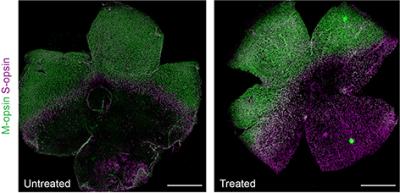
In vivo correction of an Rpe65 mutation by adenine base editor (ABE) prolongs the survival of cones in LCA mouse model. Image credit: Nature Communications
A new University of California, Irvine-led study indicates base editing may provide long-lasting retinal protection and prevent vision deterioration in patients with inherited retinal degeneration, specifically in Leber congenital amaurosis (LCA) patients.
LCA is the most common cause of inherited retinal degeneration in children. LCA patients with RPE65 mutations show accelerated cone photoreceptor dysfunction and death, resulting in early visual impairment. It is therefore crucial to develop a robust therapy that not only compensates for lost RPE65 function, which impair the visual cycle and contribute to retinal degeneration, but also protects photoreceptors from further degeneration.
“In this study, we found that the base editing treatment can rescue the function and survival of cone photoreceptors on a long-term basis in the rd12 mice, which exhibit rapid cone photoreceptor degeneration,” explained senior author Krzysztof Palczewski, Ph.D., Donald Bren Professor of Ophthalmology at the UCI School of Medicine.. “Protecting photoreceptors is key to preventing further deterioration of vision in LCA patients, which means this discovery could lay the foundation for establishing the therapeutic potential of base editing as a one-time, durable treatment.”